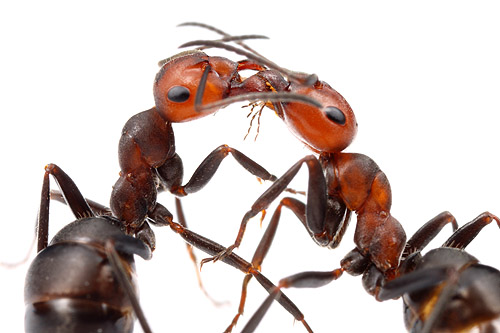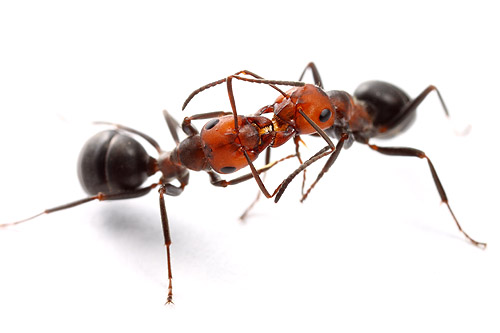
Formica obscuripes
Trophallaxis- the social sharing of regurgitated liquids- is a fundamental behavior in the biology of most ant colonies. One ant approaches another, asks for a droplet of food, and if her partner is willing the two spend anywhere from a few seconds to several minutes in what is best described as a myrmecological french kiss. The behavior is so central to the life of ants that the insects have an entire stomach, separate from their digestive gut, devoted as a reservoir for social sharing.
Although the act involves a transfer of food, it would be a mistake to think of the behavior as primarily a nutrient-dispersal mechanism. Ants do it far more frequently than nutrition requires. Trophallaxis also transfers chemical signals among nestmates, regulating a singular colony odor and sharing information about the needs of the colony. Think of it as the colonies' own internet.
Over the weekend I set out to rectify my rather embarrassing lack of decent trophallaxis photographs. We have a laboratory colony of Formica obscuripes that are ideal subjects, as these large ants are not only charismatic but engage in trophallaxis with what seems to be a nearly pathological frequency. Here are a few of the better shots.



To capture this series, I borrowed a technique from Benoit Guenard. I set a tall tupperware container inside the open, fluon-lined plastic tub housing a large and active laboratory ant colony. A 6" square of white paper affixed to the top of the tupperware created a plain white platform. In essence, I made a raised stage that allowed for photographing the ants in side view while still retaining them in their escape-proof nest.
Once the ants accept the structure they behave relatively normally on it, as if the platform were a natural extension of their territory. A drop of honey water entices them to feed, followed minutes later by a predictable cascade of trophallaxis.

Fantastic photographs. When you say these ants are large, what size do you mean?
Amazing photos.
The largest workers are about 8mm long. Not huge by insect standards, but pretty big as far as ants go.
Are you using flash or a constant light source?
These are with the MT-24EX twin flash, diffused. The first two images were done with the two flash heads in their regular position. For the bottom two I hand-held one head behind the ants and turned down the power on the other.
Wow! And not just because the photos are spectacular--because they are...breathtaking in fact--but because this behavior is compelling in its intimacy and functionality.
So cool
These two ants appear to have different faces or at least head shapes from one another. Is it possible to tell individual ants apart by appearance or is this just a visual illusion?